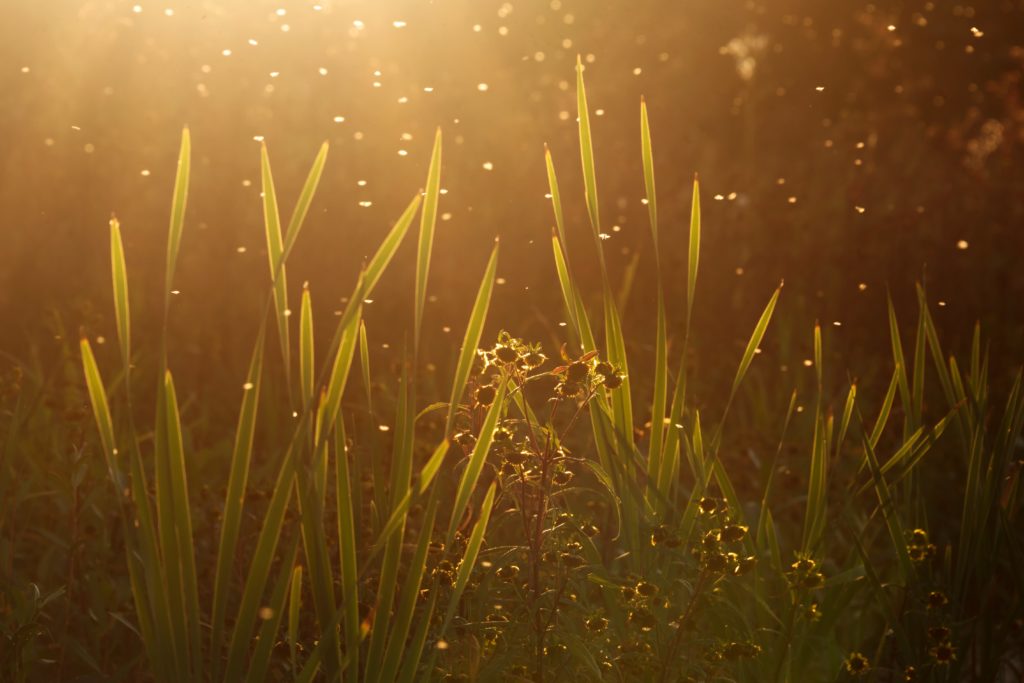Did you know that gnats are in the same order as mosquitoes? Gnats tend to be around New York from early Spring, until Summer temperatures tick in around mid-June. Luckily, Mosquito Joe of Staten Island offers gnat repelling services, letting you enjoy your yard swat-free!
What are Gnats Attracted to?
Many things in your yard may attract and produce breeding conditions for gnats. Gnats require two things in order to breed – moisture and some type of rotting organic matter.
Here are a few things that may be attracting gnats to your yard:
- Overwatering your lawn
- Build-up of grass clippings
- Rotten logs
- Dead plants
- Unremoved stumps
Gnats are also attracted to the following things in your house:
- Rotting food
- Overly ripe fruit
- Food left in the garbage disposal
Gnat Life Cycle
Gnats will move through their life cycle in approximately 30 days. During this time, the male gnats will swarm at dusk and mate with the female who has entered the swarm. From there the female gnat will look for moist soil to lay about 300 eggs and a total of 1,000 eggs during her lifetime. “The typical Gnats on your property are not a human health issue and more of a nuisance. However, you may experience an itching sensation if a large amount of them are present and the Eye Gnat can be quite bothersome.” Says our own David Price Associate Certified Entomologist, Director of Technical Services. However, by reducing areas in your yard that help them breed you’ll keep the population under control!
How to Get Rid of Gnats Outside:
Mosquito Joe of Staten Island is here to help you get rid of gnats in your yard. Gnats are attracted to moisture, fruits, and vegetables, and decaying organic matter. Many of these can be found outside near garbage cans, sewers, and even your garden.
Tips to get rid of gnats in your yard:
- Place rotting fruit and vegetables in closed containers or bags in garbage cans and dispose as soon as possible.
- Let waterbeds dry between each watering of plants and gardens.
- Get rid of decaying organic matter such as leaves.
- Avoid using moss beds.
What Types of Gnats Are There?
How to effectively get rid of gnats will depend on the type of gnats you’re dealing with. There are thousands of species of gnats. Here are some of the species you are most likely to encounter inside and outside your home.
Although the midge life cycle lasts less than three weeks, from egg to adult, they can be quite a nuisance for people trying to enjoy outdoor activities. No-see-ums will readily bite humans and pets, causing painful and itchy areas on the skin. Those allergic to no-see-ums (biting midges) may also experience long-lasting sores around the bite areas.
Sand flies thrive in humid conditions that also have a dry area, which helps protect their eggs. The entire sand fly lifecycle is 20-40 days, with the eggs taking 1-2 weeks to develop into larval. Pupae develop into adults within 10 days.
If bitten by a sand fly, you may experience a bumpy red rash around the bite area. Some people can also get a fever due to a gnat bite. Sand flies can also transmit viral infections like Chagres Virus and Punta Toro Virus.
These gnats thrive in areas of loose, sandy soil and have a life cycle that varies based on the temperature, food, and moisture available. Adult females consume blood, animal sweat, secretions, and pus, to store protein for the pupa and larval stage. Females lay up to 400 eggs in 2-3 days, and adults typically live about 28 days.
These gnats can be a nuisance for anyone working or playing outside. They target and bite their prey around the neck and head area and can be very aggressive. Black flies can kill large animals with their persistent harassment. Fortunately, they only live about 2-3 weeks and usually disappear during the hottest months of the summer.
Mosquito Joe of Staten Island Will Help Rid Your Yard of Gnats!
Our trained technicians are equipped with the necessary tools to rid your yard of pesky gnats and make outside fun for you and your family. Give Mosquito Joe of Staten Island a call today at (718) 540-5259 for a free quote!


